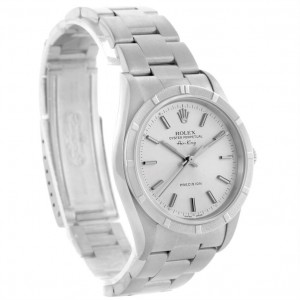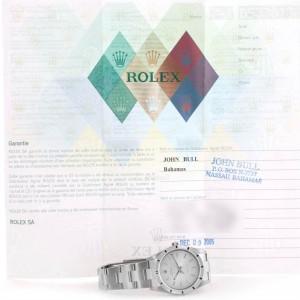There’s an unspoken allure to owning a Rolex-a symbol of craftsmanship, heritage, and timeless style. Yet, not every model earns its crown. Among the storied collections, the Air-King occupies a curious niche, blending wartime legacy with postwar pragmatism. While its origins are steeped in aviation heroism, one iteration stands out as a cautionary tale for enthusiasts: the 34mm neo-vintage Air-King. Released in 1989 as reference 14000, this model embodies an identity crisis-too modest for modern tastes, yet stripped of vintage charm. Let’s unravel why this replica watch fails to soar. 
A Legacy Grounded in History
The Air-King’s genesis traces back to the 1940s, when Rolex crafted tributes for RAF pilots. The original ref. 4925, with its bold 34mm case-a marvel for its era-bore the name “King” to signify its stature among smaller “Air” siblings like the Air-Lion and Air-Tiger. By the 1950s, the ref. 5500 emerged, enduring for three decades with its clean dial and steadfast proportions. Yet, as wristwatches evolved, Rolex’s commitment to the Air-King wavered. While the Explorer ref. 1016 adopted a contemporary 36mm case in 1963, the Air-King clung stubbornly to 34mm, its movements lacking even chronometer certification-a telling oversight for a brand synonymous with precision.
The 1990s: A Case of Diminishing Returns
By the late 1980s, Rolex attempted a refresh. The ref. 14000 debuted with a sapphire crystal and updated caliber 3000, but its case remained frozen in time. For collectors in the ’90s, this was a baffling choice. Wristwatch trends had shifted toward bolder sizes, yet here was an Air-King that felt almost dainty. The author’s firsthand experience underscores this dissonance: saving diligently for a Rolex, only to find the 14000’s 34mm frame underwhelming. “It resembled a child’s toy,” he recalls, comparing its presence to a ruler of Legoland, not wrists. The eventual pivot to a 40mm Explorer II-despite its own flaws-highlighted the Air-King’s irrelevance in an era craving substance. 
Half Measures and Missed Opportunities
Rolex’s attempts to reinvigorate the line only deepened its identity crisis. The 14010 added an engine-turned bezel, echoing the Turn-O-Graph’s flair, but the 34mm case neutered its impact. Later models, like the 2007 ref. 114234, introduced a white gold fluted bezel-a hallmark of Rolex elegance-yet even this glimmer couldn’t compensate for the shrunken silhouette. Technical upgrades, such as the chronometer-certified caliber 3130, felt like bandages on a fractured design philosophy. Meanwhile, the Milgauss and Explorer families embraced modern proportions, leaving the Air-King adrift in a sea of progress.
The Vintage vs. Modern Dilemma
For enthusiasts today, the neo-vintage Air-King occupies a purgatorial space. Vintage models like the ref. 5500 thrive on nostalgia, their smaller sizes forgiven as relics of a bygone era. Their acrylic crystals, rattling bracelets, and “Precision” dials exude charm precisely because they aren’t modern. But the 14000 series? It straddles an awkward divide-too recent to evoke nostalgia, too outdated to compete with contemporary icons like the 40mm Explorer II or the audacious 2016 Air-King ref. 116900. Priced between €4,000 and €6,000, these models demand compromise: sacrificing either modern craftsmanship or vintage character, without delivering either.
A Crown Worthier of the Name 
Rolex finally retired the 34mm Air-King in 2014, reviving it in 2016 with a muscular 40mm case and aviation-inspired dial. The latest ref. 126900 rectifies earlier missteps, blending sporty vigor with refined details. Yet one wonders: What if Rolex reimagined the Air-King not as a homage to jet-age speedometers, but to its own heritage? A 38mm interpretation, echoing the mid-century Milgauss, with alpha hands and minimalist elegance, could honor the original 4925 while embracing modern tastes.
The neo-vintage 34mm Air-King is a lesson in horological dissonance. For collectors, it represents neither a prudent investment nor a satisfying wear. Its size alienates modern wrists; its design lacks the patina that forgives vintage quirks. If you seek a Rolex with soul, dive into pre-1989 models or save for the contemporary iteration. The middle ground, it seems, is where legends go to fade.


